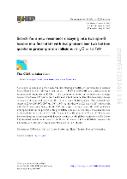Search for a new resonance decaying into two spin-0 bosons in a final state with two photons and two bottom quarks in proton-proton collisions at √s=13 TeV

Autor
Tumasyan, A.
Adam, W.
Andrejkovic, J. W.
Bergauer, T.
Chatterjee, S.
Damanakis, K.
Dragicevic, M.
Del Valle, A. Escalante
Hussain, P. S.
Jeitler, M.
Datum vydání
2024Publikováno v
Journal of High Energy PhysicsRočník / Číslo vydání
neuveden (5)ISBN / ISSN
ISSN: 1029-8479Metadata
Zobrazit celý záznamKolekce
Tato publikace má vydavatelskou verzi s DOI 10.1007/JHEP05(2024)316
Abstrakt
A search for a new boson X is presented using CERN LHC proton-proton collision data collected by the CMS experiment at root s = 13 TeV in 2016-2018, and corresponding to an integrated luminosity of 138 fb(-1). The resonance X decays into either a pair of Higgs bosons HH of mass 125 GeV or an H and a new spin-0 boson Y. One H subsequently decays to a pair of photons, and the second H or Y, to a pair of bottom quarks. The explored mass ranges of X are 260-1000 GeV and 300-1000 GeV, for decays to HH and to HY, respectively, with the Y mass range being 90-800 GeV. For a spin-0 X hypothesis, the 95% confidence level upper limit on the product of its production cross section and decay branching fraction is observed to be within 0.90-0.04 fb, depending on the masses of X and Y. The largest deviation from the background-only hypothesis with a local (global) significance of 3.8 (below 2.8) standard deviations is observed for X and Y masses of 650 and 90 GeV, respectively. The limits are interpreted using several models of new physics.
Klíčová slova
B Physics, Hadron-Hadron Scattering, Higgs Physics, Photon Production,
Trvalý odkaz
https://hdl.handle.net/20.500.14178/2987Licence
Licence pro užití plného textu výsledku: Creative Commons Uveďte původ 4.0 International






